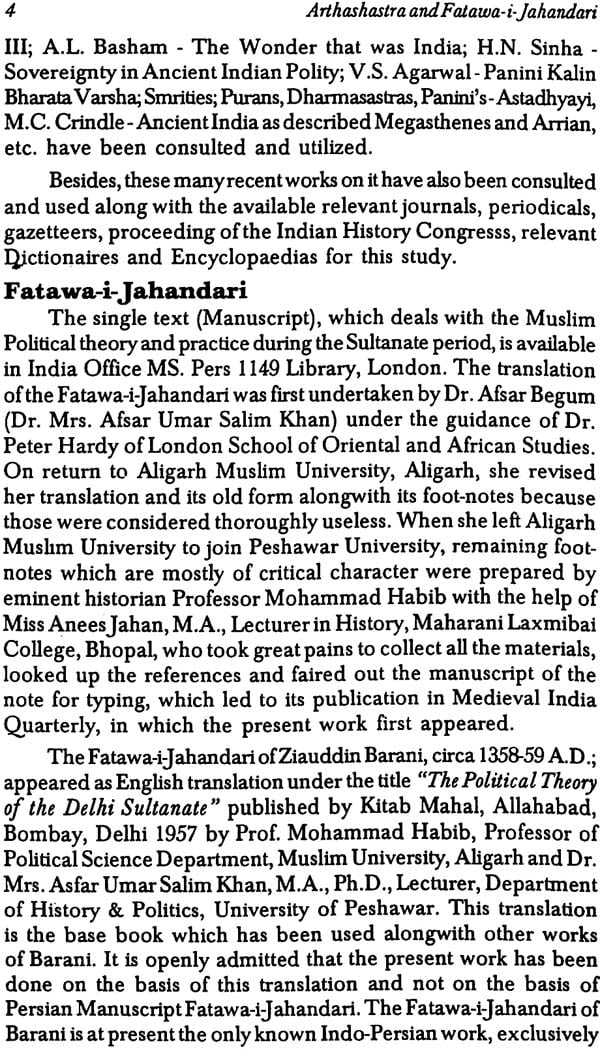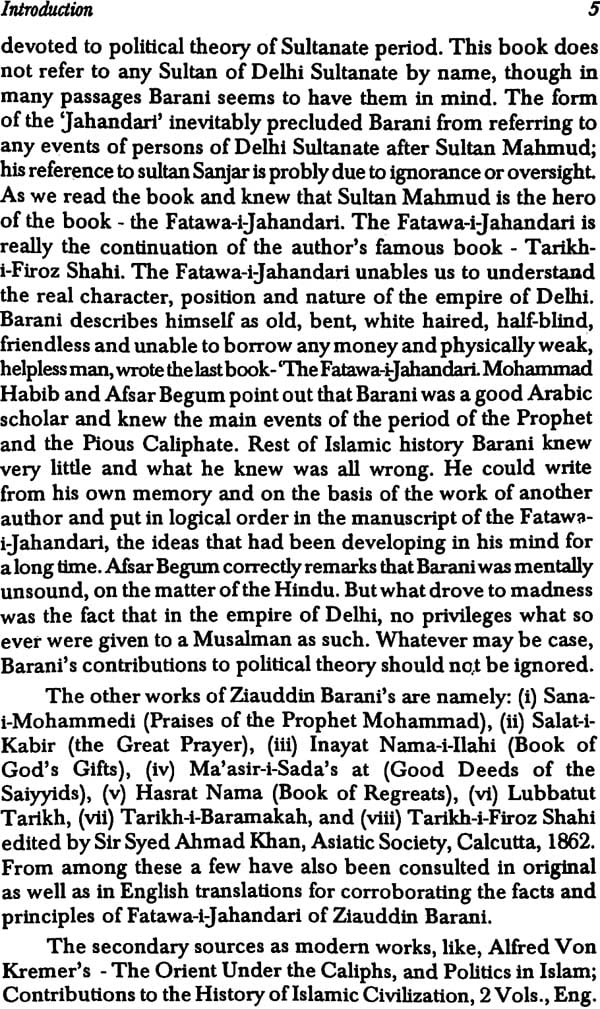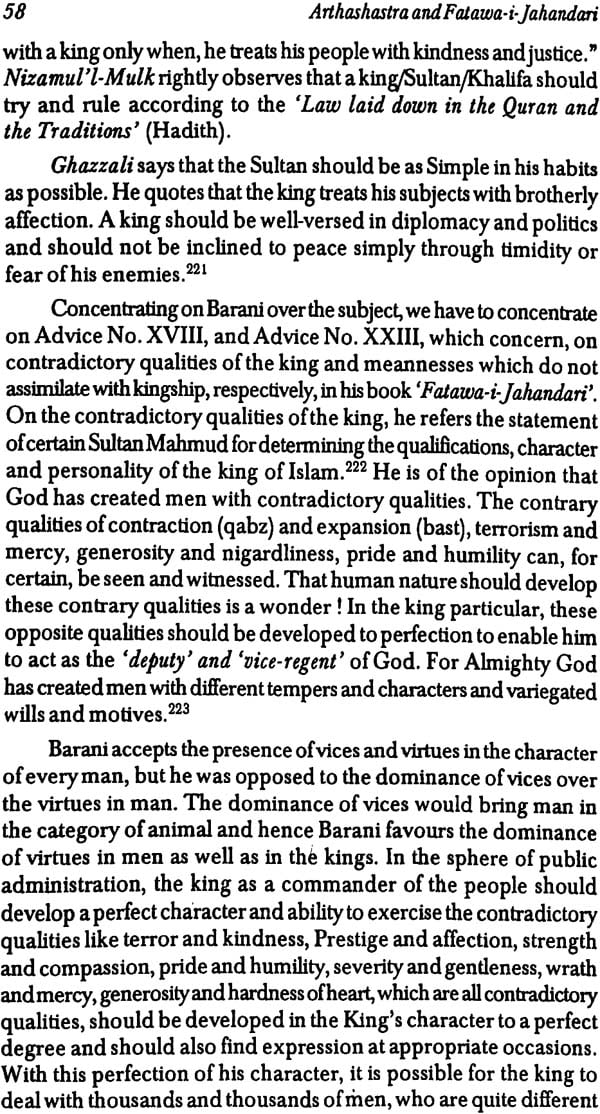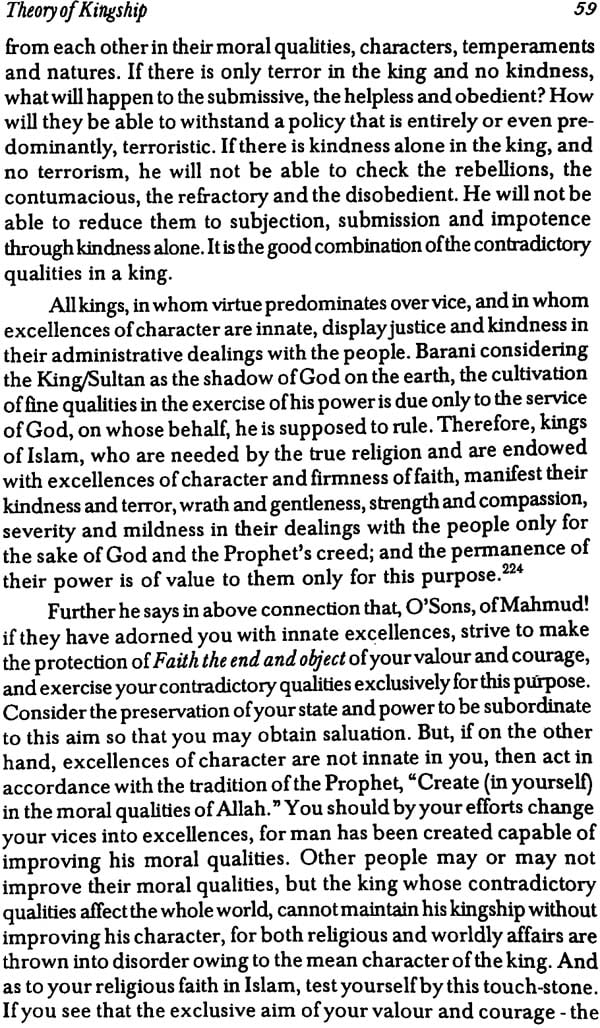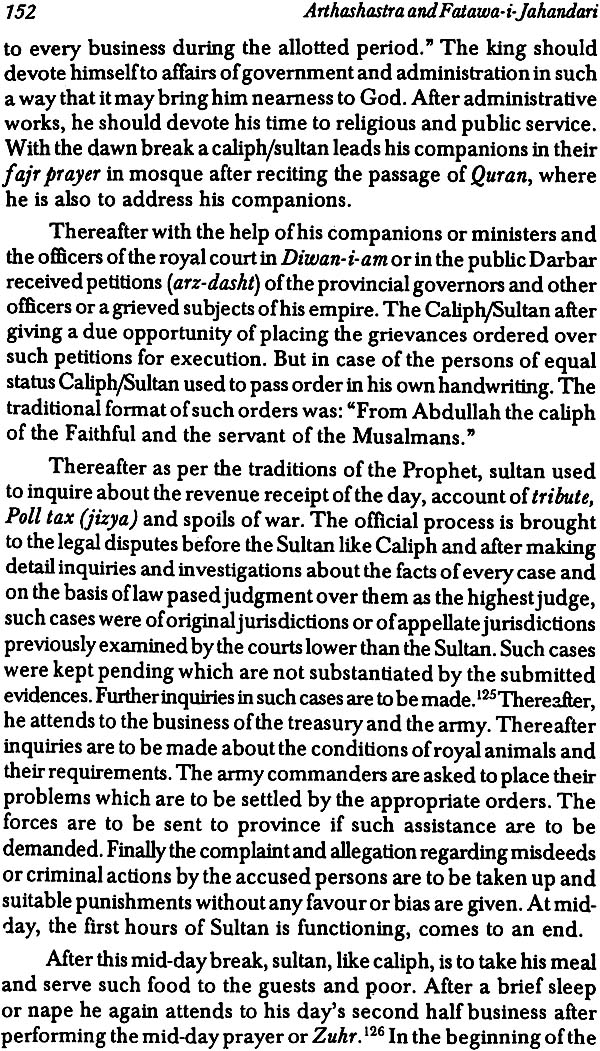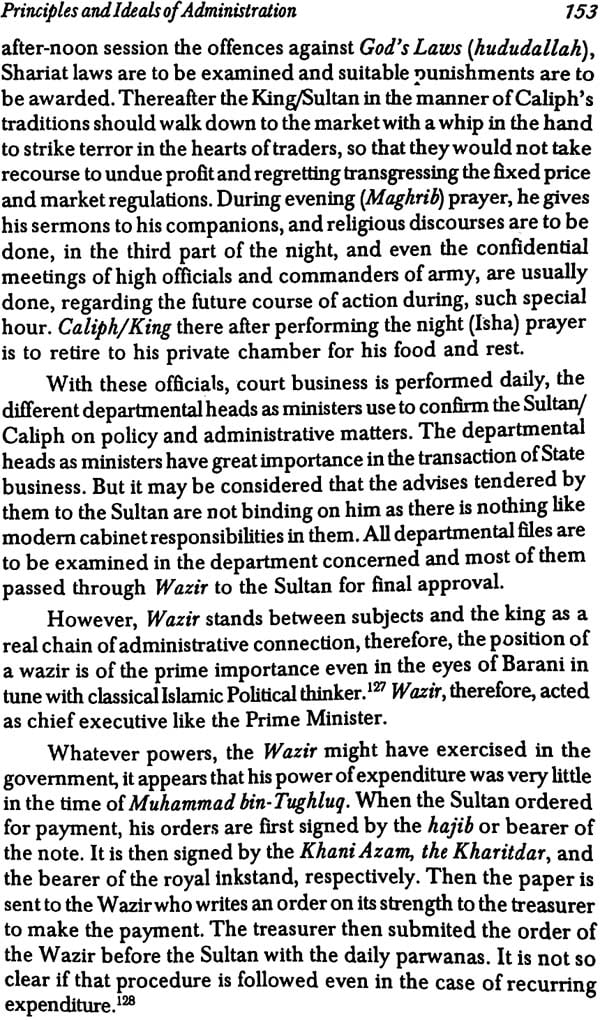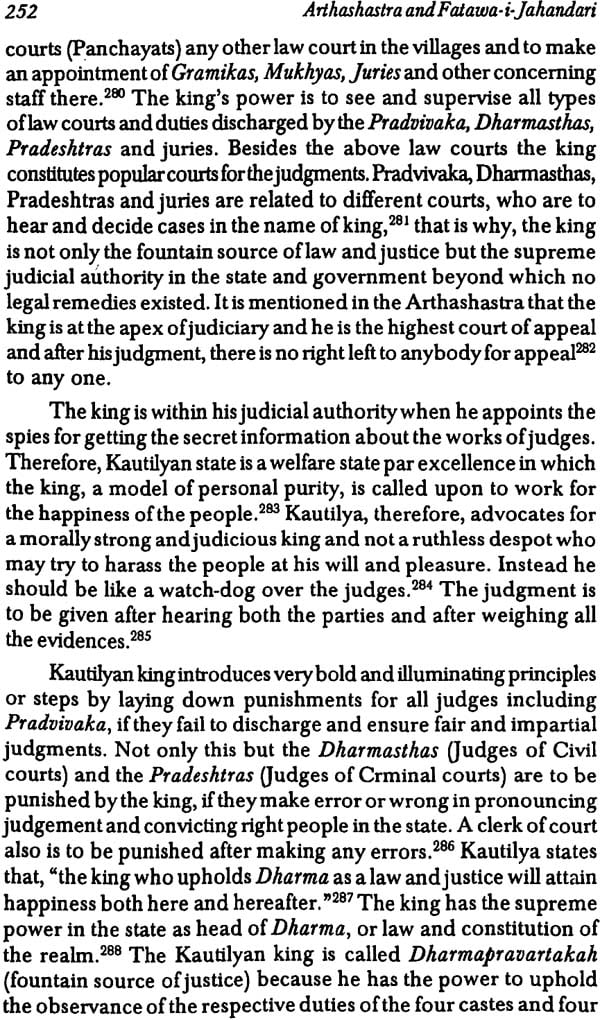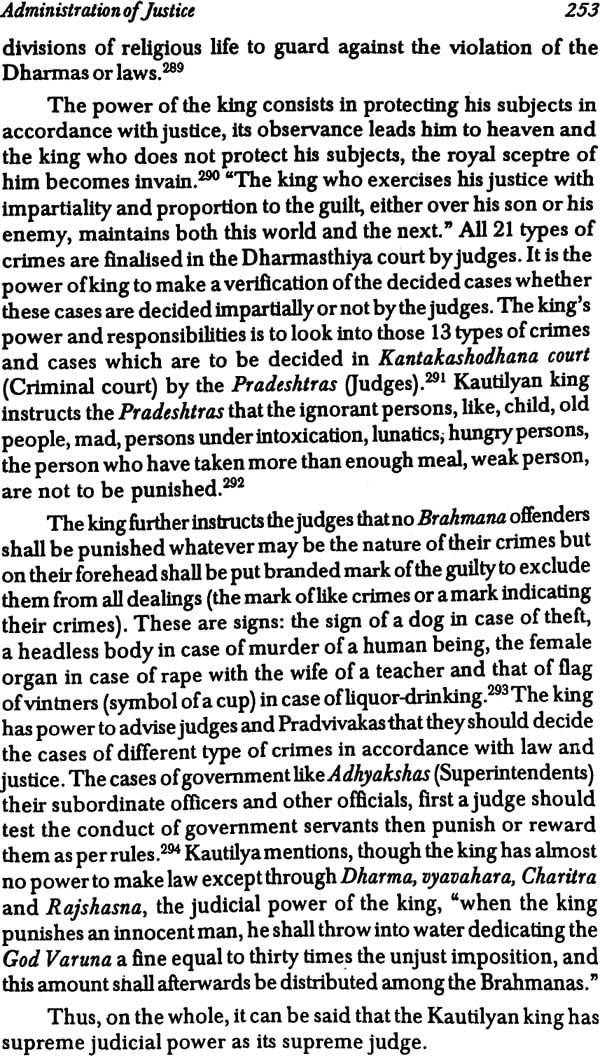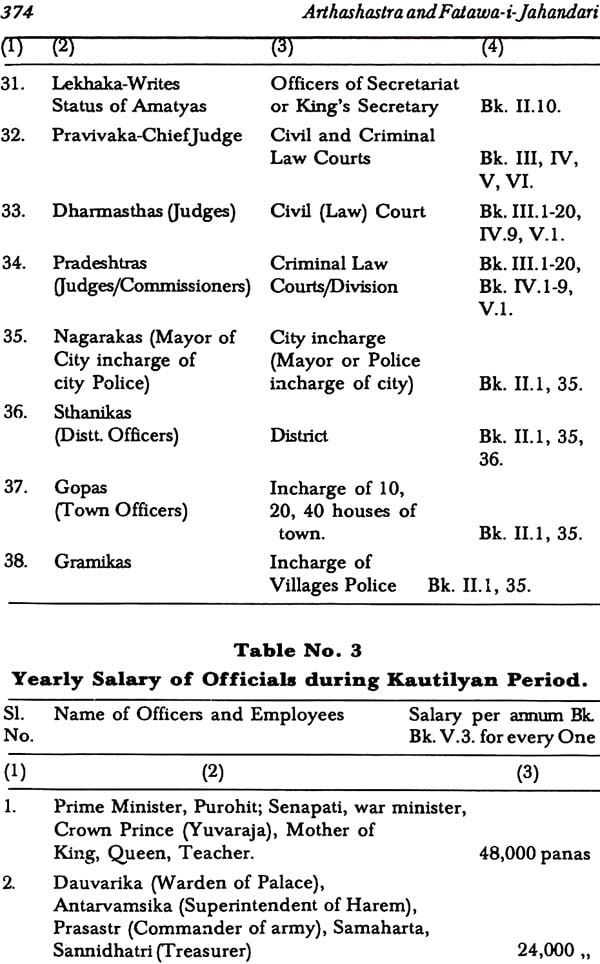
Arthashastra of Kautilya and Fatawa-I-Jahandari of Ziauddin Barani (An Analysis)
Book Specification
| Item Code: | NAO737 |
| Author: | Arbind Das |
| Publisher: | Pratibha Prakashan |
| Language: | English |
| Edition: | 1996 |
| ISBN: | 8185268452 |
| Pages: | 404 |
| Cover: | Hardcover |
| Other Details | 9.0 inch X 6.0 inch |
| Weight | 560 gm |
Book Description
The book - a theoretical analysis and constitution, is a treatise on Arthashastra of Kautilya and Fatawa-i- Jahandari of Ziauddin Barani, like a constitution for the rulers of ancient and medieval periods. It is a compendium of the two for the use of those, who are not acquainted either with the Arthashastra or with the Fatawa-i-Jahandari. An intellectual bridge has been constructed to fill up the gap between ancient and medieval political scientists. It will inrich the knowledge of the scholars of Indian history through its exhaustive comparative study. The two separate compartments of our study of Indian history usually made to standby the scholars in the above fields, will be minglled into one for the natural and normal flow of continuty of our history. In this sense, the present study is specially significant.
The content of the book covers mainly some important aspects of state-craft of Kautilya and Barani, like life and thought, theory of kingship, Principles and ideals of administration of justice, economic principles and at last the conclusion.
Dr. Arbind Das was born on 01.01.1948 in Munger District (Bihar), Passed Matric-1965, B.A. Hons. 1969, B.Ed., - Bhagalpur University, M.A. History - Bihar University, Muzaffarpur, D.Litt. - Bhagalpur University honoured by UGC-Teacher's Fellowship Award in 1988, and book Publication grant sanctioned by ICHR-New Delhi under the financial assistance this book is in the light.
The author is regularly contributing research articles in standard journals and also associated with the professional Historians bodies like Indian History Congress etc.
Presently a senior lecturer in History Deptt. Marwari College, Kishanganj. Senator and formerly Dy. Registrar of B.N. Mandal University, Madhepura, (Bihar).
The present work Arthashastra of Kautilya and Fatawa-i-Jahandari of Barani: An Analysis by Dr. Arbind Das is the out come of the autor's constant academic pursuit.
It is a well known fact that there are numerous conflicting theories in every country and in every age. Among the ancient Indian Smritikars or Political scientists Kautilya stood second to none. His Arthashastra is a compendium of all the Arthashastras or Dandaniti. It stands unique in the history of political thought. Kautilya accumulated and catalogued all the available data on statecraft, diplomacy, economic management and practically left no branch of theoretical and practical knowledge untouched in his unique treatise the Arthashastra. The Arthashastra was meant exclusively for the people amidst which its author lived and in that sense it differed from any utopion idealism of the east and the west. Kautilya was a confirmed realist. He made clear distinction between religion, politics and economics and based his treatment on scientific reasoning. He adopted the emperical and scientific method and achieved near perfection. For Plato, Aristotle, Machiavelli, Adam Smith, Marx, J.R. Hicks, Graham Wallas and scholars of modern business management and state craft, the Arthashastra of Kautilya was of utilitarian value.
The Fatawa-i-Jahandari of the famous historian and legist, Ziauddin Barani is the only surviving treatise of the early medieval period (Delhi Sultanate) brought before the scholars by Professor Mohammad Habib and Dr. (Mrs.) Afsar Umar Salim Khan. It is exclusively devoted to political theory in the form of Advice numbering twentyfour (XXIV). The basis of the Fatawa-i-Jahandari was not altogether the Shari'at of Islam but the Zawabit or the state laws made by the king for realising the welfare of the state and the people. Barani leaves us in no doubt that in cases of conflict the State laws overrode the Shari'at. Its foundation was nevertheless non-religious and secular but definitely based upon his pragmatic approach to the practice of traditions and their application by the kings. His Advices ranged from the personal safety of the king, correct determination, tyranny, despotism justice, punishment, price-control, Army, doctrine of contradiction, disease of the kingdom, on the high born and low born and the like. They make this work of political theory almost equal to Arthashastra of Kautilya.
The effort of the author to analyse the two treatises of two different periods and of two different religious communities in one is nothing less than a gigantic task. The author's effort is close to the saying of Voltaire, "I wish to write history not of wars but of society, and to asertain how men lived in the interior of their families and what were the arts which they commonly cultivated only he wanted to work like a minor to find in this "Mississippi of falsehood" and like to see and travel on the track of real history of mankind." Kautilya and Barani tried to provide the basic track to human behaviour and existence like pragmatist theorists. The author's task was no less than a minor who has to delve deep to reach at the bottom layers of the two different mines to compare and contrast the ores of knowl-edge stored by Kautilya and Barani.
Before this effort scholars of Ancient Indian History with Sanskrit back ground could know Kautilya's Arthashastra as a work of Hindu scholar in the compartmentalized frame. Now a Muslim scholar can know him in depth and a non-Muslim scholar who has not at home in Persian language can read Barani's treatise Fatawa-i-Jahandari with keen interest. The comparative study of the two treatises of the two Indian thinkers of two different ages and communities in the shape of this book would find them in a new field of study not available till date. It will also help the foreigners interested in Indian History and Politics to understand the essentials of the corporate life of Indians.
For the fundamental knowledge of the two treatises, the author has chosen the arduous task of placing the theories of Kautilya and Barani seperately before giving the comparision and contrast of them chapter and sub-chapterwise. Thereafter he has given his own findings. This is definetely to help the scholars of the two different fields with the first-hand knowledge without going to the actual texts analysed in this book.
Among the five chapters and various sub-chapters under them the most important are -theory of kingship, sovereignty, position of king/sultan, principles of ideal administration, theocratic, secular, tyrannical, despotic, and welfare nature of the state, classification of bureaucracy, administration of justice, sources of law, crimes and punishments, economic principle, agriculture, industry, trade, labour and their wages, market organisation and price-control measures. These areas of studies have been exhaustively analysed by the author essentially in the comparative frame.
The conclusion of the author that the "Arthashastra and the Fatawa-i-Jahandari are especially important and significant for the material basis of society and state" is significant. Appendices and their detailed tables are really a valuable contribution made by the author for those who want to have a ready-made information regarding Kautilyan bureaucracy and weapons of war. The various tables of thesis also are valuable. The book contained exhaustive bibliography which may help the future scholars, who will like to venture in the field.
The book is basically theoretical analysis without any touch with their contemporary history. It would have been all the better if the author had attempted to reach the essential feature of our history relating to the Hindu-Muslim Unity. The author's angle of analytical study was only confined to the comparative study of the important aspects of the two treatises, namely the Arthashastra and the Fatawa-i-Jahandari. It is, thus, not a total but a partial study of them.
No doubt this humble attempt of the author with his short-comings would open a new kind of field of study for the new generation of scholars.
However, we must finally praises the author for his academic pursuit of high order. It is of course hoped that it will not be considered as an end in itself.
Contents
| Foreword | vii- x | |
| Opinions | xi-xiv | |
| Acknowledgement | xv-xviii | |
| 1 | Introduction | 1- 23 |
| (i) | Purpose | 1 |
| (ii) | The Sources of Study | 3 |
| (iii) | A Biographical Background of the Evalution of Kautilya and Barani's Political Ideas | 6 |
| 2 | Theory of Kingship | 24-115 |
| (i) | Sovereignty | 24 |
| (ii) | Qualification, Personality and Character of King/Sultan | 51 |
| (iii) | Power, Function and Position of an Ideal King/Sultan | 66 |
| 3 | Principles and Ideals of Administration | 116-202 |
| (i) | IdeaIs and Nature of Government:: Theocratic, Secular, Tyrannical, Despotic and Welfare Nature of the State and Government | 116 |
| (ii) | Organization, Classification and Nature of Bureaucracy | 129 |
| (iii) | Organization of Army, Battle Strategy and its Importance | 161 |
| (iv) | Causes of the Failure of Government and End of King's Rule | 181 |
| 4 | Administration of Justice | 203-280 |
| (i) | Definition, Sources and kinds of Law | 203 |
| (ii) | Kind of Crimes and Types of Punishment | 218 |
| (iii) | Organs for the Administration of Justice | 235 |
| (iv) | Power and Position of King/Sultan as a Judge | 250 |
| 5 | Economic Principles | 281-357 |
| (i) | Economic Basis of State and Government | 281 |
| (ii) | Theory of Collection of Taxes and Expenditure | 288 |
| (iii) | Agricultural Economy | 301 |
| (iv) | Industries, Labour, Labour Organization and Wages | 313 |
| (v) | Theory of Price Control and Market Regulations | 332 |
| Conclusion | 359-370 | |
| Appendices | 371-378 | |
| Appendix - I | 371 | |
| Appendix - II | 375 | |
| Bibliography | 379-394 |
